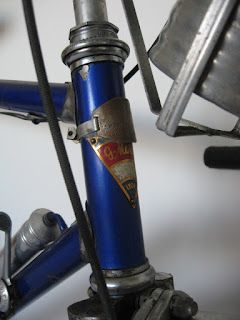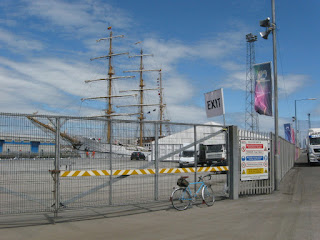The bicycle is a rare 1952 Georges Martin randonneuse and was made in Lyon, France. The bicycle has 700C wheels, and is similar to machines raced in events such as the Poly de Chanteloup. The bicycle does not have a decaleur, nor a sacoche. The bicycle is completely original, down to the tax plate on the head tube with the original owner's details. The machine has some rare, high end and unusual parts.
Georges
Martin was born in
Chamelet, Rhone Department, France in 1915 and
died in
Poule-les-Écharmeaux in 2010 aged 94 years. Georges rode
professionally for
J FOLLIS, Lyon. He is credited with one hundred
victories according to the excellent
Anciens Velos Lyonnaise website. Georges rode and won the Circuit de Six Provinces
in 1946:-
Both
Martin and Baratin were team mates for
FOLLIS. Georges rode in the first post war
Tour de France in 1947. The teams were national teams, but teams
from both Germany and Italy were missing, an
Italian team being composed of Italian-French. Georges Martin rode
for a regional French Team – Equipe du Nord-Est.
The
1947 Tour started in Paris on 25th
June 1947 and comprised of 21 stages, there were 99 starters, but
only 53 riders completed the race, which was won with an average
speed of 31.412km/hr. The top three podium places were all filled by
French riders:-
Georges
Martin rode in the 1948 edition of the Tour de France achieving 39thin the General Classification (G.C.) at the end of the race. The
1948 Tour was won by Gino Bartali in an average speed of 33.442km/hr.
Georges rode the 1949 Tour improving his overall position to 35
th
overall by the end of the race. The 1949 Tour was won by Fausto Coppi in an average speed of 32.121 km/hr. The speeds seem slow by
modern standards, but stages could be longer and the mountain stages
were run on un-metalled roads. Georges Martin also rode the 1949
Classic Paris - Roubaix achieving a position of joint third with Frans Leenan and Jésus-Jacques Moujica.

I
have no information on the colour of the 1940s FOLLIS team frames and
trade jerseys. There is some evidence that the 1950's FOLLIS team
jersey was green with a wide grey centre band on which the lettering
was red. The colour of the team bikes was a metallic grey, with
contrasting head and seat panels in pale metallic blue. Forks were
chrome plated along with the head lugs. Earlier frames had the 'J
FOLLIS' metal
head badge. It is known that FOLLIS supplied frames to the cycle
trade. FOLLIS had been granted a patent for the manufacture of
lugless frames in Janury 1949. A WOLHAUSER (Lyon)
tandem lugless frame is known, which shows
all the features of being made by FOLLIS but has a WOLHAUSER
metal head badge and transfers.

I now know that Georges Martin finished riding
professionally in 1950, but he began selling bicycles under his own name
firstly at 78 Rue de la Part-Dieu, Lyon, then at 101 Rue Moncey, Lyon
and finally at Rue du Noir, Lyon. The Georges
Martin bicycle in the Springhill Cycle
Collection dates from 1952 and shows a lot of features of an early
edition FOLLIS frame. The frame fittings and wrap over seat stays
are typical FOLLIS, but the fork crown is unique to Georges Martin.
Given his connection to FOLLIS and the fact they were known to supply
frames to the cycle trade, the evidence points to Georges Martin's
frames having been built by FOLLIS and
appear to have been built from Vitus tubing.
However, Georges Martin was interviewed by a French researcher
before his death. The
truth of some of his testimony is in doubt, as known facts are
different to Georges'
version. What is known is that Georges
Martin bicycles are rare in France. The
bicycle in the Springhill Collection is in original condition
complete with period components, Simplex derailleur,
Pellisier hubs and Ava rims, Beborex brake levers with 'San Giorgio' brake
callipers, 'Radios'
dynamo and lights, Mavic 'Inal'
mudguards/fenders, Selle Anglais leather saddle. The machine has the
original French tax plate with original
owner's name and address still attached to
the frame. The only replacement parts appear to be the Christophe
leather toe straps.

The machine has 700C
wheels and appears to be set up for
cyclotourist competitive
events. The December 1950 issue of the CTC
Gazette contains a report on the Paris Bike Show of that year. Their
correspondent reports on the number of constructeur Demi-Course and Randonneur
bicycles at the show. A
Demi-Course bicycle has mudguards/fenders and lights but no decaleur
for a sacoche/handlebar bag. Recourse to photographs from
the 1950s of the Poly de
Chanteloup
randonneurs
event, show machines
being ridden with mudguards and lights but no racks or bags. Some of
these machines have
the alloy drinks bottles in a cage attached to the handlebar as per
the Georges Martin in the Springhill collection. The 1950 Poly de Chanteloup was won by FOLLIS, Pierre Baratin winning the
professional hillclimb and Roger Billet winning
the randonneur event
for FOLLIS. Since the end of competative cycletourist hillclimbs,
time trials and endurance events in France from 1977, the term
Demi-Course now seems to refer more to cheaper mass produced machines made
from Hi-Ten tubing, rather than a bespoke hand built bicycle around
an artisan constructeur built frame for cyclotourist competition. The Georges Martin in the
Springhill Cycle Collection is a lightweight steel frame built up
with high quality,
for the time period, components.
Joseph
(Giuseppe) Follis was born in Alpignano, near Turin on 16th
October 1911 and after living and working in Lyons became a
naturalised French citizen on 11th
March 1940, before Italy declared war on France on 10th
June 1940.

According to eye witnesses Joseph Follis had worked for
Morel & Vana, Lyon in the 1930s and was responsible for the
production of their FORTIS brand of bicycles. Following closure of
the company, Joseph moved to the
Rue du Dauphiné
where he brazed frames in a wooden hut
at the bottom of the garden. The Follis family were innovators who
were granted patents for derailleur gears, manufacture of frames and
bicycle brakes. The patent granted to the Follis family for a
bicycle brake in November 1951 corresponds in principle to the locally
(Lyon) manufactured BEBOREX brakes and levers. FOLLIS is perhaps not
a French marque that is as well known as say LeJeune, Helyett,
Peugeot, Mercier and Motobecane. The two
known professional riders in the 1940s were Georges Martin, Pierre
Baratin and André Mossière
who rode cyclocross events.

George's
daughter held a retrospective two day exhibition in
Poule-les-Écharmeaux
entitled in english –
'Georges Martin, the heroic years of the Tour de France' on 9 –
10th
July 2011, the year after Georges had passed. I wish I could have
been there.


















































